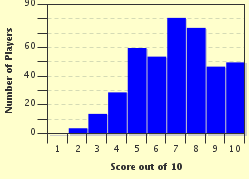Quiz Answer Key and Fun Facts
1. Charlotte comes to the office with a question about the menu for a birthday party she's planning. "The restaurant has a list of appetizers to choose from," she tells Dr. Lergy, "but they all sound like seafood to me!" Poor Charlotte can't eat anything that's lived in water. Which of the following dishes is safe for her?
2. Alice tells Dr. Lergy that she's thrilled about her upcoming tour of South America, but there's one problem: her serious allergy to citrus fruit. "Lemons, limes, oranges, grapefruit -- any one of them could ruin my vacation," she says. Which of these national dishes should Alice avoid?
3. Mildred, a student about to reach the legal drinking age, comes to the office for advice on her upcoming birthday celebrations. "I'd like to celebrate at an international bar with my friends," she tells the doctor, "but I'm worried about my rice allergy." Which of these drinks would be a dangerous selection?
4. Edgar is allergic to eggs, but he's tired of having to avoid the complimentary bread at every restaurant he goes to. "I know they don't mean to, but I feel like I'm being ripped off!" he complains to Dr. Lergy. Which of the following breads is most likely to contain eggs?
5. Alphonse is planning a vacation to India. As he shows Dr. Lergy his guidebooks and planned itinerary, he reminds him that he's terribly allergic to fish of all kinds. Which of these dishes should he avoid?
6. Morgause has been looking forward to her Egyptian vacation for months, but her wheat allergy could hamper her enjoyment of the pyramids. Which of the following dishes is most likely to cause her trouble?
7. Six-year-old Seth is allergic to milk, but he has his heart set on a birthday outing to a nearby dessert restaurant. Which of these desserts should Dr. Lergy advise him to try?
8. Dr. Lergy has just diagnosed Paul with an allergy to soy protein, which makes most soybean products off-limits. Luckily, the doctor has a list of common soy products, which Paul reads through. "Sho-yu sauce, miso, edamame ... hmm, it looks like one of my favorite restaurants was causing the rash!" Paul realizes. Which type of cuisine includes those staple items?
9. Annabelle's allergy to peanuts and tree nuts (walnuts, almonds, pine nuts and so on) is serious indeed -- so serious that she has always shied away from both cookies and thick sauces. "It's really limiting my dining options," she tells Dr. Lergy. Which of these dishes will certainly be safe for Annabelle to eat?
10. Eugene arrives at the office very upset: he had a bad reaction the previous evening, while at a Mexican restaurant. "I was just eating a turkey dish," he tells Dr. Lergy, "when all of a sudden I could barely breathe. I'm lucky I had my EpiPen with me! What's going on, Doc? I'm allergic to chocolate, not turkey!" Which of these Mexican sauces contains chocolate?
Source: Author
CellarDoor
This quiz was reviewed by FunTrivia editor
ozzz2002 before going online.
Any errors found in FunTrivia content are routinely corrected through our feedback system.

